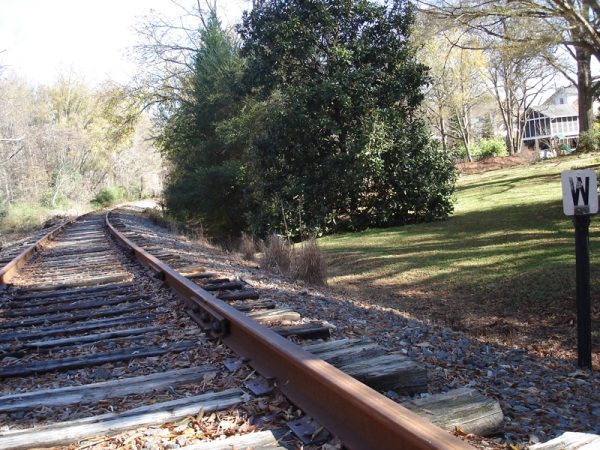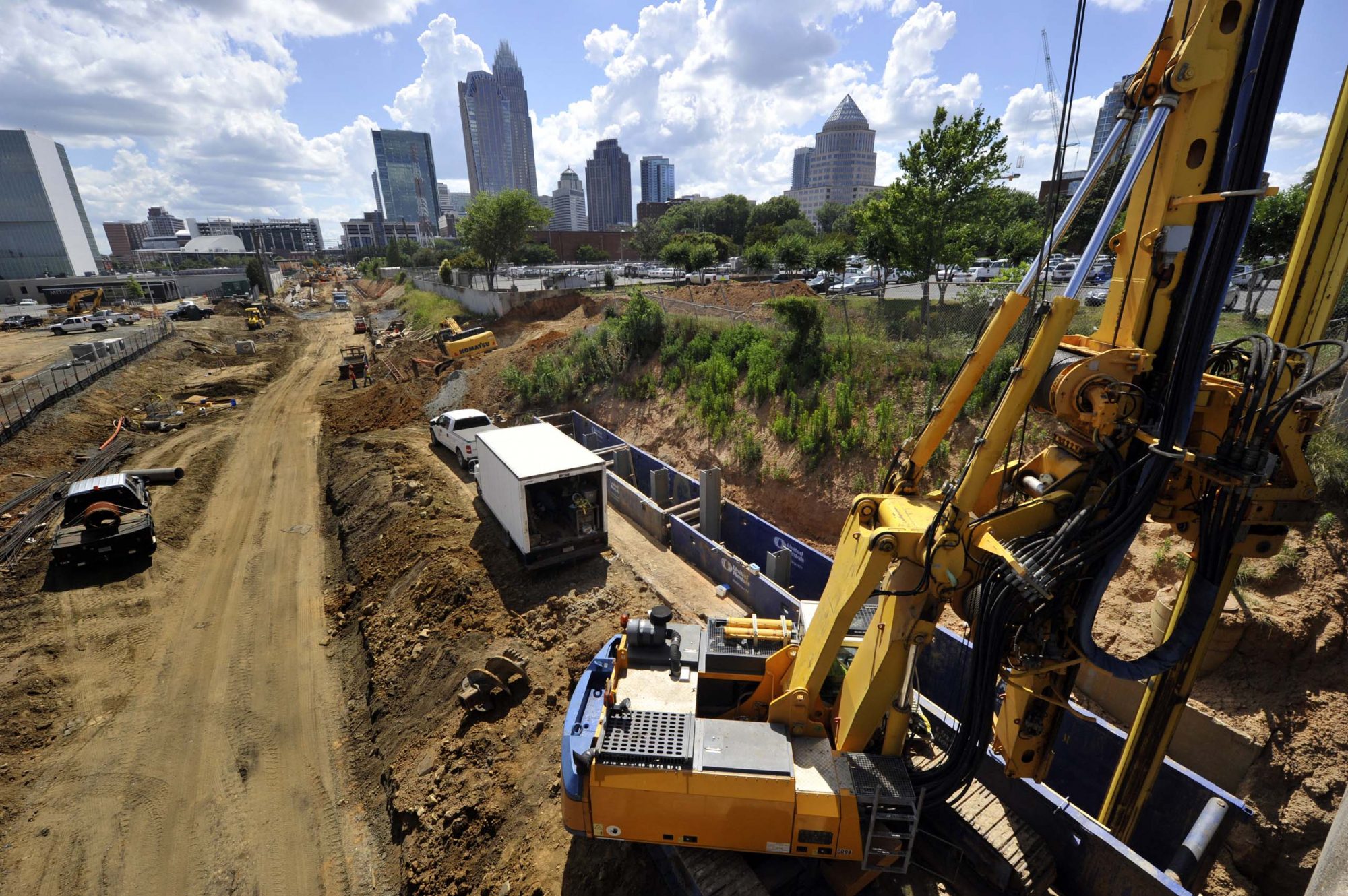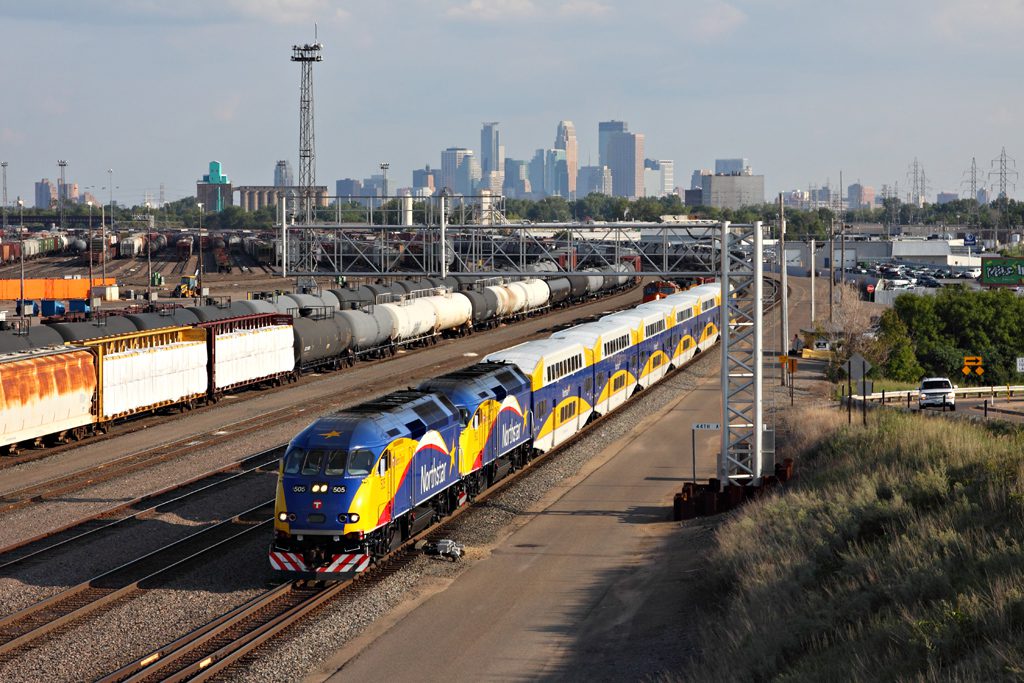Growing congestion, empty tracks: Why there’s still no Red Line to North Meck

A set of almost deserted railroad tracks runs from uptown Charlotte through Huntersville, Cornelius and Davidson. In fast-growing, highly congested north Mecklenburg, people see those tracks and ask: Why not use them for mass transit?
For more than 20 years, that’s what the county’s transit plan has proposed: Use the tracks for a commuter rail service called the Red Line. Yet no commuter rail line has been built.
Since a Charlotte task force last year proposed seeking an additional one-cent county sales tax for transportation projects, on top of the half-cent OK’d in a 1998 referendum, the unbuilt Red Line has become a sticking point for some north Mecklenburg civic and elected leaders. On a February “Charlotte Talks” show on WFAE, Mecklenburg County Commissioner Elaine Powell, who represents the area, said, “It feels like we’ve been fleeced.” On March 15, the Huntersville Town Board adopted a resolution opposing any new transit tax. Other Mecklenburg County commissioners have expressed doubts.
Opponents complain they haven’t got what they were promised from the existing tax. The Lake Norman Chamber of Commerce came out against it, with its CEO, W. E. “Bill” Russell, writing in an opinion piece: “Instead of getting new rail lines from Charlotte to Lake Norman as promised to gather our support, voters from North Mecklenburg received little more than a lesson in ‘bait and switch’ politics.”
What follows is an attempt to set the record straight about why that Red Line hasn’t been built. Was it a “bait and switch,” or a fleece job? That’s for you to decide.
First, here’s a summation of today’s situation: The plan to use those tracks for commuter rail is essentially dead in the water, probably for decades. Norfolk Southern controls them, occasionally uses them for freight, and won’t share them with commuter rail. A change of heart appears about as likely as a flock of hogs taking wing over Lake Norman.
That means any public transit to north Mecklenburg will almost certainly have to go somewhere else. And all the “somewhere else” possibilities for rail transit – whether commuter rail or light rail, and no, they are not the same – involve steep construction difficulties or massive costs, or both. A recent Charlotte Area Transit System study concluded the most feasible way to bring rapid mass transit to the area will be via buses – Bus Rapid Transit, which operates like light rail but with buses on dedicated lanes, not rails. For CATS, those lanes would be the I-77 express lanes, opened in 2019.
Further, any referendum on a proposed sales tax increase is unlikely this year: The N.C. General Assembly must give permission for a vote, and with local officials lacking unanimity, most observers say its prospects are bleak. Even if the vote were to be OK’d, it isn’t likely due to delays in Census data needed for legally required redistricting in some local races.
From here, the story gets a bit complicated, so get a comfy chair. The tale involves seemingly arcane things like a state-owned set of tracks from Charlotte to Morehead City, an odd street name in Charlotte, and a pre-Civil War Tennessee railroad charter.
Why promise a rail line and then not build it?
From the earliest days of Charlotte-Mecklenburg’s transit planning, rail transit was envisioned from uptown Charlotte to the three fast-growing north Mecklenburg towns, and maybe even Mooresville. That was the pitch during both the 1998 referendum and a 2007 revote on the tax.
What isn’t widely known is this: When the 2030 Transit Corridor System Plan was adopted in 2006, Norfolk Southern Railway had a written agreement to let the Charlotte Area Transit System (CATS) share its tracks for commuter rail from Charlotte through north Mecklenburg.
Then, as now, NS was using the rail line, known as the “O” line, for freight. Today it sees maybe one freight train a week.
Sharing the tracks would dramatically lower CATS’ cost to build any rail transit there. The 2006 agreement, detailed in a 2008 memo to CATS’ files, called for CATS to pay a $22 million license fee to use the tracks for 50 years between 5:30 a.m. and 9 p.m. CATS would also pay for upgrading the tracks to make them suitable for passenger rail. In exchange, NS agreed to give passenger rail priority on the tracks during those hours.
This wasn’t starry-eyed dreaming either. CATS had reason to believe NS would honor the O line agreement. CATS had worked with NS to buy easements adjacent to the freight tracks beside South Boulevard for the Blue Line and paid to do construction work on the NS corridor. Because of that written 2006 agreement with NS, the Red Line for a time was considered a strong candidate to be the second or third line built after the Blue Line opened in fall 2007.
If there was an agreement, why don’t we have a Red Line?
Interviews with people involved in Red Line planning then and now point to several reasons.
Norfolk Southern changed its mind. The railroad company never legally formalized that 2006 agreement. In addition, a key NS negotiator, vice president Craig Lewis, died. In 2013, Norfolk Southern’s Passenger Rail Policy changed, to disallow transit service on freight corridors, including the O Line. Why that corporate change? We’ll get to that in a bit.
Recession. The economy went off a cliff in 2008, and CATS’ sales tax revenues tanked, wreaking havoc on projections made in earlier boom years. The system couldn’t afford all the new lines it had planned. Other than the Blue Line Extension, CATS didn’t couldn’t build any Red Line or the proposed corridors heading west and southeast of uptown Charlotte.
Federal transit funding rules. The Federal Transit Administration typically pays 50% of building a new transit line – but only if plans meet certain parameters, such as strong projected ridership and a stable and adequate local funding source. Funding is competitive; the federal transit dollars are limited. That 50% share from the feds is crucial for an expensive transit project. After sales tax receipts plummeted, and the state changed its funding practices (see below) the funding for the other 50% was iffy. Further, Red Line ridership projections were also iffy.
Now, time for some rail transit wonkiness. Commuter rail and light rail are different. Light rail is usually electrified with overhead wires. It has more frequent service and close-together stations. Stringing wires from poles is expensive. So is more frequent service. Those costs can be offset by higher ridership from dense development nearby. Commuter rail goes farther afield with less frequent service and doesn’t usually use overhead wires. The Red Line commuter rail was planned to run only a few trains a day because of ridership projections.
With limited service and tracks through what were, in the 1990s and 2000s, undeveloped or low-density tracts ridership projections made it a weaker candidate for the same pot of federal money that funded the Blue Line and Blue Line Extension. By the time development revived after the recession, NS had nixed the use of its tracks, sending the Red Line into limbo. Several Red Line-oriented developments proposed years earlier are being built with lower densities, or aren’t built.

Construction on the Blue Line extension in Charlotte from uptown to UNC Charlotte. Photo: Nancy Pierce
State transit funding all but vanished. The old formula undergirding transit plans from 1998 and 2006 was for the state to pay 25% of new transit construction. That formula is kaput. After Republicans captured the N.C. General Assembly in 2010 and the governorship in 2012, a 2013 state law changed how transit was funded, dramatically reducing what state money could be spent and forcing a city’s transit projects to compete directly with both rural and urban highway projects. (The state honored its 25% commitment for the Blue Line Extension because contracts were already signed.)
Is any rail transit – light rail or commuter rail – for north Mecklenburg even feasible now?
That may depend on what you consider “feasible.” Several scenarios come to mind, but how likely are they?
CATS did a big update in 2018-19 of its 2030 Transit Corridor System Plan. In the section on the Red Line, it flat out says: “The previously-adopted North Corridor LPA [locally preferred alternative] cannot be built under current conditions.” However, CATS also says commuter rail on the O line remains the agency’s long-term goal. (CATS has no current cost estimates for the Red Line; a 2011 estimate, assuming use of the O line, was $452 million.)
Scenario 1: CATS uses eminent domain to buy the O line tracks.
This may sound like an easy solution, but it’s legally impermissible due to laws about railroad property.
Further, precisely who owns the land under the tracks is murky. David Carol of the American Public Transportation Association studied the Red Line while working at CATS 2003-2009, and as a consultant with WSP from 2009 to 2018. This ownership quirk is rooted in history. The O line was chartered as a Tennessee railroad before the Civil War. Under this Tennessee charter, a rail company had rights to use the land for tracks but if it wasn’t being used as a railroad, rights reverted to the landowners. The upshot: It’s unclear whom you’d be buying the tracks from. Norfolk Southern contends it does own the underlying rail property, Carol says. Any answer to the ownership would almost certainly come after a protracted and expensive court case.
Fun fact: That early railroad was the Atlantic, Tennessee and Ohio railroad – the ATandO – remembered today in the name of Atando Avenue, which crosses the O line as it runs beside Graham Street north of uptown, in a neighborhood known to railroad buffs as Atando Junction.
Scenario 2 – Find another route for transit from Charlotte to north Mecklenburg.
In 2018-19, CATS evaluated six potential transit routes in the North Corridor, including the O line and I-77, as well as routes east and west of I-77. For multiple reasons – protected watersheds, rural areas with low-density development, impact on historic downtown buildings, etc. – three were rejected early. The remaining options were light rail on U.S. 21, commuter rail on the O line, and bus-rapid-transit (BRT) on I-77 or U.S. 21. (Full report can be downloaded here.)
After assessing factors such as expense, construction difficulties and impact on downtowns, the report concluded the most feasible option was to expand CATS’ current express bus service on the I-77 toll lanes, aiming for all-day service from all the park-and-ride lots, or “mobility hubs.” Although not pure BRT, it could offer, for example, times of 30 minutes to Huntersville’s Northcross area and about 40 minutes to Davidson. CATS began expanding its north Mecklenburg express bus service in February 2020, but almost at once the pandemic forced all express bus service to cut back. It’s not known what ridership the expanded service will attract when it resumes.
Why not build a rail transit line beside U.S. 21? A primary reason is that the N.C. DOT plans to widen U.S. 21, creating a multilane, freeway-like “superstreet.”
Why not build rail transit beside the O line? Because Norfolk Southern claims a 50-foot of right-of-way on either side of the track centerline. In some places N.C. 115 (Old Statesville Road) is within that claimed right-of-way. Further, building a transit corridor next to that 100-foot-wide swath or alongside N.C. 115 would blast through downtown Huntersville, Cornelius, and Davidson. That option was dismissed as too disruptive and expensive.
Scenario 3. Norfolk Southern reverses, lets commuter rail share the O line.
Among the transportation experts I talked with, none considered it likely Norfolk Southern would change its mind. One official who would only speak off the record put it this way: “It’s dead as it’s always been.”
As they described it, NS is playing the long game, and the O line is its leverage. Why? Let’s get back to that state-owned railroad mentioned earlier.
The North Carolina Railroad, which owns tracks running from Charlotte to the Morehead City port, dates to1848. The NCRR is owned by the state but run by a private company, with the state as its only shareholder. (Yes, it’s odd.) Its tracks carry Amtrak as well as freight. Norfolk Southern, through predecessor companies, had a 100-year lease (1899 to 1999) to use the NCRR tracks. As 1999 approached, the lease was renegotiated, and NS is now in the second of three 15-year renewable leases. The first ended in 2014. The current lease runs through 2029, renewable until 2044.
NS would prefer either to own the tracks or win a much longer lease. Without those things, the railroad says it must keep the O line available for freight in case it needs an alternative route, should NS ever be unable to use the NCRR’s Charlotte-Greensboro line.
NS spokesman Jeff DeGraff said on Thursday that “at this time we have not reconsidered our stance on this proposal.” He said freight operations are “customer-driven” which precludes setting aside “passenger-only” daytime hours and night-time only freight operations, as the 2006 agreement had done.
As former CATS CEO Ron Tober, who helped negotiate that 2006 agreement, puts it: “I don’t want to say they’re bluffing. They have a lever and they’re exercising it.”

The Northstar commuter rail line in Minneapolis, which uses tracks and right-of-way owned by BNSF. Photo: Jerry Huddleston
Could Norfolk Southern be persuaded to reverse its position?
Sustain Charlotte, a nonprofit advocacy group, has launched a petition drive urging NS and the NCRR to work with CATS to allow commuter rail onto the O line. As of Tuesday, March 23, it had more than 1,300 signatures.
An earlier attempt at persuasion came in 2016, when then-U.S. Transportation Secretary Anthony Foxx, formerly Charlotte mayor, pulled together a high-level meeting in Washington. Then-Davidson Mayor John Woods was there and described what happened. NCRR president Scott Saylor attended, along with a top NS official, the mayors of Charlotte and the north Mecklenburg towns, plus former CATS chief Carolyn Flowers, then at USDOT. Woods recalls that Foxx told the group he’d lock the door and they couldn’t leave without finding a solution to let CATS use the O line. But Foxx then left.
Woods says Norfolk Southern wanted “permanent control” of the NCRR’s freight tracks. He took that to mean a 50- or 100-year lease.
After a lot of discussion about the O line, Woods recalls, the NS representative simply said, “We’re not going to do that. … The meeting fell apart after that.”
Woods said he still believes NS could be persuaded, if CATS and NCDOT and other agencies worked together to bargain with the railroad. But, he said, “I honestly believe Norfolk Southern is just holding on to the O line in hopes they can get everything they want.”
Tober, who worked for a consulting firm that studied the North Corridor in 2018 and 2019, said he thinks Norfolk Southern could come out ahead if they negotiated with CATS. “There’s a business case for Norfolk Southern doing this,” he said. The railroad would get money for letting CATS use the right of way, with CATS paying for maintenance. He said he’s baffled why Norfolk Southern doesn’t see that. “It’s a win-win-win for them.”
Mary Newsom is a lifelong newspaper journalist who spent several decades at The Charlotte Observer as an editorial board member and columnist, concentrating on Charlotte regional urban and suburban growth, planning, urban design, transportation and land preservation. She left the Observer and joined the UNC Charlotte Urban Institute in 2011. She had a year-long Nieman Fellowship at Harvard University 2007-08, and in 2005-06 was a Knight Fellow in Community Building at the University of Miami. Newsom retired from the insitute in 2018 as Director of Urban Policy Initiatives, and is now a freelance writer in Charlotte.